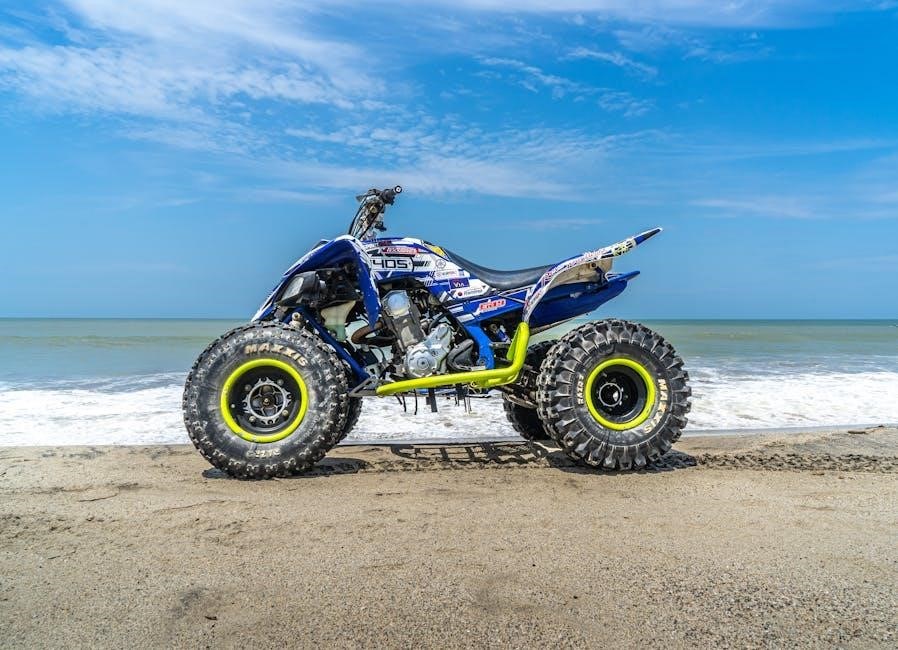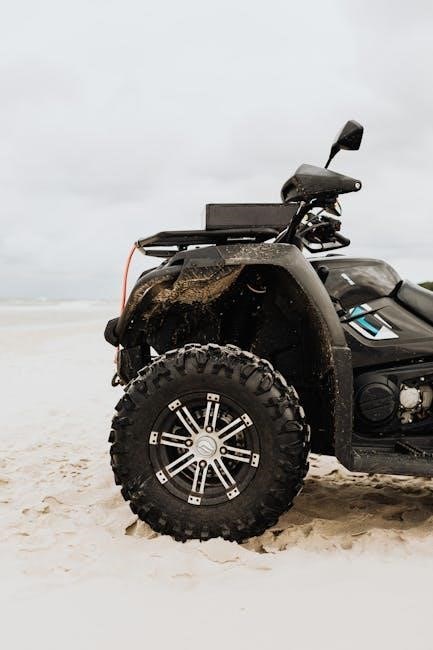Understanding tire size components is crucial for optimal ATV performance. This guide helps you navigate tire width, diameter, profile, and construction to ensure proper fitment and enhanced riding experiences.
Importance of Proper Tire Size for ATV Performance
Proper tire size is essential for maximizing your ATV’s performance, stability, and safety. Incorrect tire dimensions can lead to poor handling, reduced traction, and increased risk of accidents. Tire width and diameter directly impact ground contact and clearance, affecting how your ATV navigates various terrains. Oversized tires may require lift kits to maintain proper clearance, while undersized tires can compromise stability. Additionally, mismatched tires can strain the engine and transmission, leading to decreased efficiency and potential mechanical damage. Ensuring your tires match the manufacturer’s specifications or suit your riding conditions is vital for optimal power delivery, maneuverability, and overall riding experience. Always consult a tire fitment guide to avoid costly mistakes and ensure your ATV operates at its best.
Overview of ATV Tire Size Components
An ATV tire size is typically represented by a series of numbers and letters, such as 26×8-14. The first number (26) indicates the tire diameter in inches, while the second number (8) represents the tire width, also in inches. The third number (14) refers to the wheel diameter in inches, ensuring compatibility with your ATV’s rims. Additionally, the tire profile (e.g., 70) is expressed as a percentage of the width, indicating sidewall height. Understanding these components is critical for selecting tires that match your vehicle’s specifications and riding conditions. Proper sizing ensures optimal performance, stability, and safety, while incorrect sizes can lead to poor handling and potential damage to your ATV.
Understanding ATV Tire Size Components

ATV tire sizes are defined by diameter, width, and profile, each critical for performance and safety. These measurements ensure proper fitment and optimal handling across various terrains.
Tire Diameter: Measurements and Implications

Tire diameter is a critical measurement, typically expressed in inches, representing the total height of the tire. It is essential to match this dimension with your ATV’s wheel size for proper fitment and performance. A larger diameter increases ground clearance and can improve stability on rough terrain, while a smaller diameter may enhance acceleration. However, mismatched diameters can lead to issues like incorrect speedometer readings and reduced handling. Always ensure your tire diameter aligns with your vehicle’s specifications to maintain optimal functionality and safety. Proper sizing ensures better traction, control, and overall riding efficiency, making it a fundamental aspect of selecting the right ATV tires for your needs.

Tire Width: How It Affects Stability and Traction
Tire width, measured in inches or millimeters, significantly impacts an ATV’s stability and traction. Wider tires provide a larger contact patch, enhancing grip on surfaces like mud or sand, while narrower tires excel on hard, smooth terrain. A wider tire improves lateral stability, reducing the risk of tipping, but may add weight and affect maneuverability. Conversely, narrower tires offer better acceleration and agility but can compromise traction in loose conditions. Choosing the right width depends on your riding environment and preferences. Proper width ensures optimal performance, safety, and control, making it a vital consideration when selecting ATV tires for specific terrain or applications. Balancing width with other factors like diameter and profile is key to achieving the best overall riding experience.
Tire Profile: Sidewall Height and Its Impact
Tire profile, expressed as a percentage of the tire width, determines the sidewall height. A higher profile offers a smoother ride and better off-road cushioning, while a lower profile enhances stability at higher speeds. For example, a 70-profile tire has a sidewall height of 70% of its width. A taller sidewall provides more flexibility on uneven terrain but may compromise handling precision. Conversely, a shorter sidewall improves responsiveness and reduces rollover risk but can lead to a harsher ride. Choosing the right profile depends on your riding style and terrain. Proper sidewall height ensures a balance between comfort, stability, and performance, making it a critical factor in selecting the ideal ATV tires for your adventures. Always match the profile to your vehicle’s specifications for optimal results.
Tire Construction Type: Bias-Ply vs. Radial
ATV tires are constructed using two primary methods: bias-ply and radial. Bias-ply tires feature layers of rubber and fabric that run at an angle, providing exceptional strength and durability, especially for heavy loads and rough terrain. They are ideal for muddy or harsh conditions due to their robust sidewalls. Radial tires, on the other hand, have layers that run perpendicular to the tire’s center, offering better traction, flexibility, and heat resistance. Radial tires are preferred for high-speed performance and precise handling. The choice between the two depends on your riding style and terrain. Bias-ply tires are often recommended for heavy-duty applications, while radial tires excel in speed and maneuverability. Always consult a fitment guide to ensure the correct construction type for your ATV’s specifications. Proper tire construction enhances both safety and performance, making it a vital consideration for any rider.
Load Ratings and Ply Ratings for ATV Tires
Load ratings indicate the maximum weight a tire can support, while ply ratings reflect durability and construction strength. Higher ply ratings, like 6-ply or 8-ply, offer greater resistance to punctures and heavy loads, ensuring optimal performance in challenging terrains. Always match the tire’s load and ply ratings to your ATV’s specifications for safety and reliability. Proper ratings enhance stability, traction, and overall riding experience, making them essential considerations for any ATV enthusiast.
Understanding Load Capacity and Its Importance
Load capacity refers to the maximum weight an ATV tire can safely support, ensuring optimal performance and safety. Exceeding this capacity can lead to reduced traction, instability, and potential tire failure. Proper load capacity is crucial for maintaining control, especially on uneven or heavy-duty terrains. It is measured in pounds or kilograms and is directly linked to the tire’s ply rating. Higher ply ratings, such as 6-ply or 8-ply, indicate greater durability and load-carrying ability. Always match the tire’s load capacity to your ATV’s specifications, considering factors like passenger weight, cargo, and terrain conditions. Ignoring load capacity can compromise safety and shorten the tire’s lifespan. Consulting a tire fitment guide ensures accurate selection, balancing load capacity with other factors like tire width and diameter for enhanced performance. Proper load capacity is essential for a smooth, reliable ride in all conditions.
Ply Ratings: What They Mean for Durability
Ply ratings indicate a tire’s strength and durability, with higher ratings offering greater resistance to punctures and wear. A 6-ply or 8-ply tire is ideal for heavy loads or harsh terrains, providing superior resilience. The ply rating reflects the number of layers in the tire’s construction, directly impacting its ability to withstand stress. Higher ply tires are preferred for muddy or rocky conditions, as they maintain structural integrity. Choosing the correct ply rating ensures long-term performance and reduces the risk of damage. For ATV owners who frequently carry heavy loads or traverse challenging trails, higher ply tires are essential for reliability and safety. Always match the ply rating to your riding habits and terrain demands to maximize durability and performance. Proper ply selection is vital for extending the life of your tires.

Terrain-Specific ATV Tires
ATV tires are designed for specific terrains, offering unique tread patterns and constructions. From all-terrain versatility to mud, sand, and snow designs, each type maximizes performance in its intended environment.
All-Terrain Tires: Versatility for Mixed Conditions
All-terrain tires are designed to deliver versatility across mixed conditions, offering a balance of traction, durability, and performance. Their tread patterns are engineered to handle various surfaces, from hardpack to mud and sand, making them ideal for riders who encounter diverse terrains. These tires typically feature a moderate tread depth and aggressive lug patterns to ensure grip on loose ground while maintaining stability on firmer surfaces. They are a popular choice for both recreational and utility purposes, as they adapt well to changing environments without compromising speed or maneuverability. Whether tackling trails, fields, or light mud, all-terrain tires provide a reliable and practical solution for ATV enthusiasts seeking a versatile tire option.

Mud-Terrain Tires: Aggressive Treads for Muddy Trails
Mud-terrain tires are specifically designed for tackling challenging muddy conditions, featuring aggressive tread patterns that maximize traction and stability. These tires are ideal for ATV enthusiasts who frequently ride in wet, muddy, or swampy terrains. Their deep tread depth and large, spaced lugs help to displace mud and debris, ensuring consistent grip and preventing the tire from getting clogged. High ply ratings, often 6- or 8-ply, enhance durability and load capacity, making them suitable for heavy-duty applications. The aggressive design allows for better self-cleaning properties, keeping the tread clear of mud for optimal performance. While they excel in muddy conditions, they may compromise comfort and noise levels on harder surfaces, making them a specialized choice for riders prioritizing off-road capability.

Sand-Terrain Tires: Design Features for Dune Riding
Sand-terrain tires are engineered to conquer dunes with ease, featuring lightweight constructions and specialized tread designs. Their wide tire widths and unique tread patterns maximize flotation, reducing the risk of sinking in loose sand. The lightweight materials enhance maneuverability, while the open tread design allows sand to escape, maintaining consistent traction. These tires are optimized for high-speed dune riding, offering superior stability and control. Proper tire pressure is critical to ensure optimal performance, as under-inflated tires can improve flotation but may compromise durability. Sand-specific tires are a must for riders seeking to dominate sandy terrains, providing the necessary grip and agility for thrilling dune adventures.
Snow-Terrain Tires: Tread Patterns for Winter Conditions
Snow-terrain tires are specifically designed to tackle harsh winter conditions, offering exceptional traction and stability on snowy and icy surfaces. These tires feature aggressive tread patterns with deep lugs to bite into snow and ice, ensuring maximum grip. The unique tread design allows for efficient snow evacuation, preventing buildup and maintaining consistent contact with the ground. Many snow-specific tires utilize specialized rubber compounds that remain flexible in cold temperatures, enhancing performance. Tire width and diameter play a crucial role, as wider tires provide better floatation, while larger diameters can improve ground clearance. Properly matched snow tires are essential for safe and effective winter riding, ensuring your ATV can handle the challenges of snowy terrains with confidence and control.
Vehicle Modifications and Their Impact on Tire Size
Vehicle modifications, such as lift kits, enable larger tire sizes by increasing clearance. Consider these changes when selecting tires to maintain performance and stability.
Stock vs. Modified Vehicles: Tire Size Considerations
Stock vehicles are designed to operate with specific tire sizes for optimal performance. Modifying your ATV, such as adding a lift kit, allows for larger tires but requires careful consideration. Stock tires ensure proper clearance, handling, and safety, while modified setups may need custom fitments. Always check the manufacturer’s recommendations for stock sizes to avoid compromising stability. If you opt for modifications, consult a tire fitment guide to ensure the new tires match your vehicle’s updated specifications. Proper alignment and clearance are essential to maintain performance and safety, whether you stick with stock or choose to modify your ATV.
Lift Kits and Their Effect on Tire Clearance
Installing a lift kit on your ATV allows for larger tires by increasing ground clearance. This modification is popular for enhanced off-road performance but requires careful planning. Lift kits raise the suspension, providing space for taller or wider tires. However, improper installation or oversized tires can lead to reduced stability or compromised handling. Always ensure the lift kit is compatible with your vehicle’s make and model. Additionally, consult a tire fitment guide to select tires that match the new clearance dimensions. Proper alignment and suspension adjustments are crucial to maintain optimal performance and safety. Lift kits offer versatility but demand attention to detail to avoid potential issues.
Choosing the Right Tire Size for Your ATV
Staying with stock sizes ensures compatibility, while upsizing may require a lift kit for proper clearance. Always consult a tire fitment guide for accurate sizing.
Staying with Stock Sizes: Pros and Cons
Staying with stock tire sizes ensures compatibility with your ATV’s original specifications, maintaining optimal performance and handling. It avoids potential issues like reduced clearance or altered suspension geometry. Stock sizes are also cost-effective, as they typically require no additional modifications. However, sticking to stock may limit performance enhancements for modified vehicles or specific terrains. Upsizing can offer benefits like improved traction or ground clearance but may necessitate a lift kit. Always consult a tire fitment guide to ensure proper sizing, especially if modifications are planned. Balancing cost, performance, and practicality is key to making the right choice for your ATV.
Upsizing Tires: Benefits and Potential Drawbacks
Upsizing your ATV tires can offer several advantages, including improved traction, enhanced ground clearance, and better stability on challenging terrains. Larger tires can also provide a smoother ride over rough surfaces and increase your vehicle’s overall visibility. However, upsizing may require modifications such as a lift kit to maintain proper clearance and avoid suspension strain. Additionally, larger tires can be heavier, potentially affecting acceleration and maneuverability. They may also be more expensive and could compromise handling if not matched to your ATV’s specifications. Always consult a tire fitment guide to ensure compatibility and avoid performance issues. Balancing the benefits and drawbacks is essential for making an informed decision.
Consulting a Tire Fitment Guide for Accuracy
A tire fitment guide is an essential tool for ensuring your ATV tires are compatible with your vehicle and riding conditions. It provides detailed information on size options, load ratings, and ply ratings, helping you avoid mismatches that could compromise performance or safety. The guide also considers modifications like lift kits, which may require larger tires for proper clearance. By referencing a fitment guide, you can identify the optimal tire size for your ATV, ensuring it handles effectively on various terrains. Always cross-check the guide with your vehicle’s specifications and consult professionals if unsure. This step is crucial for maintaining your ATV’s stability, traction, and overall performance.

Maintenance and Care for ATV Tires
Regularly check tire pressure and tread depth to ensure optimal performance. Store tires away from direct sunlight to prevent sidewall cracking and maintain their quality over time.
Proper Tire Pressure: How and When to Check
Checking tire pressure regularly is essential for optimal ATV performance and safety. Always measure pressure when the tires are cold, as driving can heat them up and give inaccurate readings. Use a reliable pressure gauge to ensure accuracy. Refer to your ATV’s owner’s manual for the recommended PSI (pounds per square inch) rating, as this varies by model and tire size. Properly inflated tires improve traction, reduce wear, and enhance fuel efficiency. Additionally, check pressure before long rides or when carrying heavy loads, as under-inflated tires can overheat and fail. Maintain consistent pressure to avoid uneven tread wear and ensure stable handling on various terrains.
Tread Depth: Monitoring for Optimal Performance
Tread depth plays a critical role in maintaining traction and control, especially on challenging terrains. Use a tread depth gauge to measure the depth across the tire’s surface, ensuring even wear. Most ATV tires should have a minimum tread depth of 2/32″ for safe operation. Deeper treads provide better grip on mud, sand, or snow, while worn treads can lead to reduced performance and increased risk of skidding. Regular inspections help identify uneven wear, which may indicate misalignment or improper inflation. Replace tires when treads reach the wear bars or show signs of excessive wear. Proper tread maintenance ensures consistent performance, safety, and extends the life of your ATV tires.
Storage Tips to Maintain Tire Quality
Proper storage is essential to maintain ATV tire quality. Store tires in a cool, dry place away from direct sunlight and chemicals. Avoid stacking tires to prevent pressure points and uneven wear. If storing for extended periods, keep them in an upright position or hang them to maintain shape. Use airtight bags to protect from moisture and humidity. Ensure tires are clean and dry before storage to prevent mold or mildew. For long-term storage, consider inflating tires to the recommended pressure to avoid flat spots. Regularly inspect stored tires for signs of damage or degradation. Proper storage practices help preserve tread depth, sidewall integrity, and overall performance, ensuring your ATV tires remain in optimal condition when you’re ready to use them again.

Future Trends in ATV Tire Technology
Future trends include advancements in materials and designs, such as lightweight compounds and smart tires with integrated sensors for real-time performance monitoring and improved durability in harsh conditions.
Advancements in Tire Materials and Design
Innovations in tire materials are revolutionizing ATV performance. Manufacturers are developing lightweight compounds that enhance durability while reducing weight, improving maneuverability. Eco-friendly materials, such as recycled rubber, are gaining traction, offering sustainable solutions without compromising quality. Additionally, advanced tread designs are being engineered to adapt to multiple terrains, providing superior grip and traction. Smart tire technologies, including pressure sensors, are being integrated to monitor real-time conditions, ensuring optimal performance and safety. These advancements not only improve ride quality but also extend tire lifespan, making them more reliable for extreme off-road adventures. As technology evolves, ATV tires are becoming smarter, stronger, and more versatile, catering to the diverse needs of riders worldwide.
Smart Tires: Integration of Technology for Better Performance
Smart tires are transforming ATV performance through cutting-edge technology. These tires now feature embedded sensors that monitor real-time data, such as pressure, temperature, and tread wear. This information is transmitted to the rider, ensuring optimal tire conditions for safety and efficiency. Advanced systems can even adjust tire settings automatically, adapting to terrain changes like mud, sand, or snow. Connectivity with vehicle systems allows for seamless integration, enhancing overall performance. Additionally, smart tires are being designed with self-healing materials that repair punctures autonomously, reducing downtime. These innovations not only improve ride quality but also extend tire lifespan, making them a game-changer for off-road enthusiasts seeking reliability and precision in challenging environments.

Popular ATV Tire Brands and Their Offerings
Top brands like Maxxis, ITP, and Kenda dominate the market, offering durable, terrain-specific tires. Each brand excels in innovation, quality, and versatility for diverse riding needs.
Top Brands in the ATV Tire Market
Leading brands like Maxxis, ITP, and Kenda are renowned for their high-quality ATV tires. These brands offer a wide range of options, from all-terrain to mud-terrain tires, ensuring durability and performance. Maxxis is known for its innovative tread designs, while ITP specializes in lightweight, high-traction tires. Kenda focuses on advanced rubber compounds for superior grip. Other notable brands include Duro and GBC Motorsports, which cater to specific riding styles and terrains. These brands consistently deliver tires that meet the demands of off-road enthusiasts, whether for recreational or competitive use. Their commitment to quality and innovation makes them trusted names in the ATV tire market.
What Sets Each Brand Apart in Terms of Quality
Each brand in the ATV tire market excels in unique aspects of quality. Maxxis is celebrated for its durable construction and innovative tread patterns, ensuring exceptional traction and longevity. ITP stands out with its lightweight designs and high-traction compounds, perfect for aggressive off-road use. Kenda is recognized for its advanced rubber compounds and wide range of terrain-specific tires, offering versatility for diverse riding conditions. Duro focuses on affordability without compromising quality, making it a favorite for budget-conscious riders. Meanwhile, GBC Motorsports is known for its high-performance tires designed for competitive racing and extreme terrains. These distinctions ensure each brand meets specific rider needs, whether for durability, performance, or value.
Selecting the right ATV tires ensures safety and performance. Always consider fitment, load ratings, and terrain-specific designs to optimize your riding experience.
Final Thoughts on Selecting the Right ATV Tires
Selecting the right ATV tires is a critical decision that impacts both safety and performance. Always prioritize proper fitment, load ratings, and terrain-specific designs to ensure optimal functionality. Consider factors like tire width, diameter, and profile, as these directly affect handling and traction. For heavy loads or harsh terrains, high ply ratings are essential for durability. Additionally, upsizing tires may require modifications like lift kits, so consult a fitment guide to avoid compatibility issues. Maintenance is equally important—regularly check tire pressure and tread depth to maximize performance and longevity. By focusing on quality and suitability, you can enhance your ATV’s capabilities and enjoy a safer, more enjoyable riding experience.
Encouragement to Prioritize Safety and Performance
When selecting ATV tires, always prioritize safety and performance to ensure a secure and enjoyable riding experience. Proper tire size, load capacity, and tread design are critical for maintaining stability and control across various terrains. Avoid compromising on quality, as inferior tires can lead to reduced traction, uneven wear, and potential failures. Regular maintenance, such as checking tire pressure and tread depth, is equally vital for optimal performance. By investing in the right tires and adhering to maintenance routines, you can enhance your ATV’s reliability and responsiveness, ensuring safer adventures and better overall performance. Remember, your tires are the foundation of your vehicle’s capabilities—choose wisely for unparalleled results.
